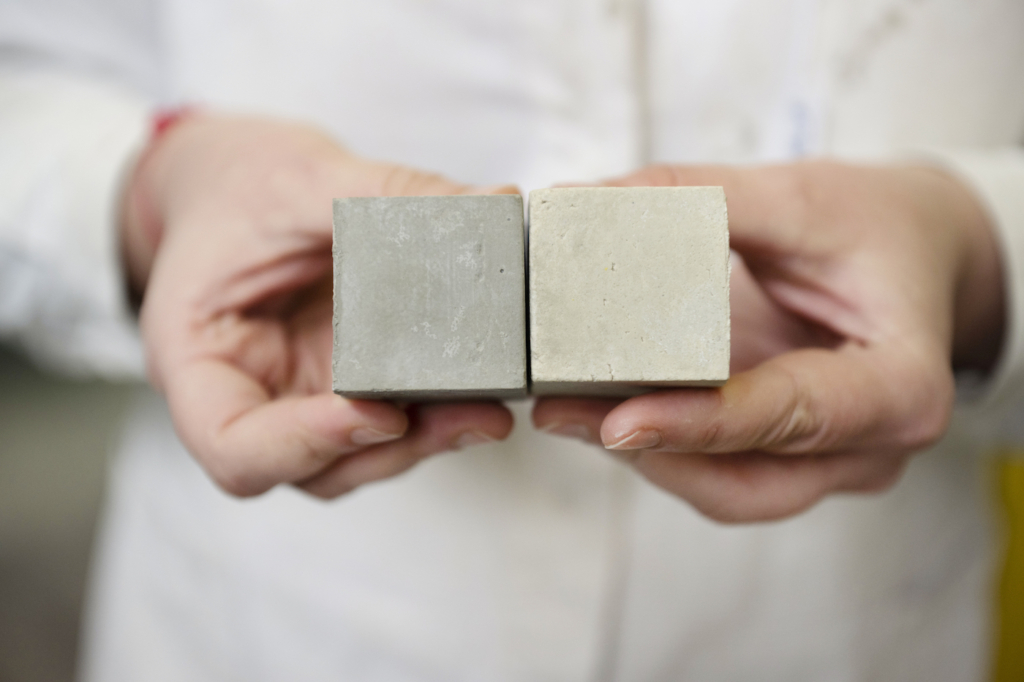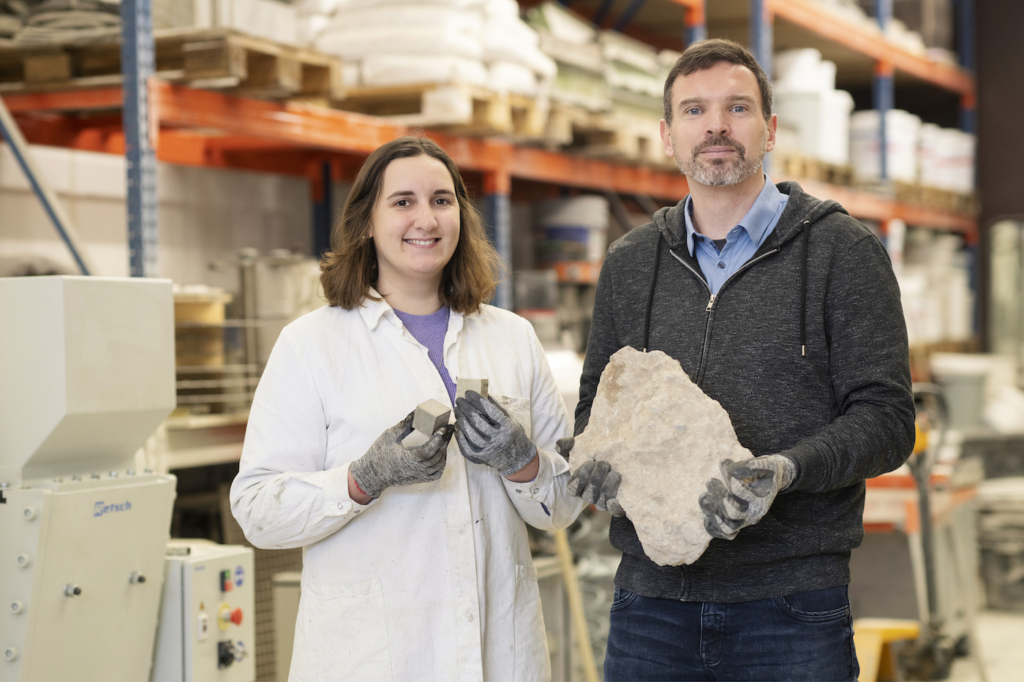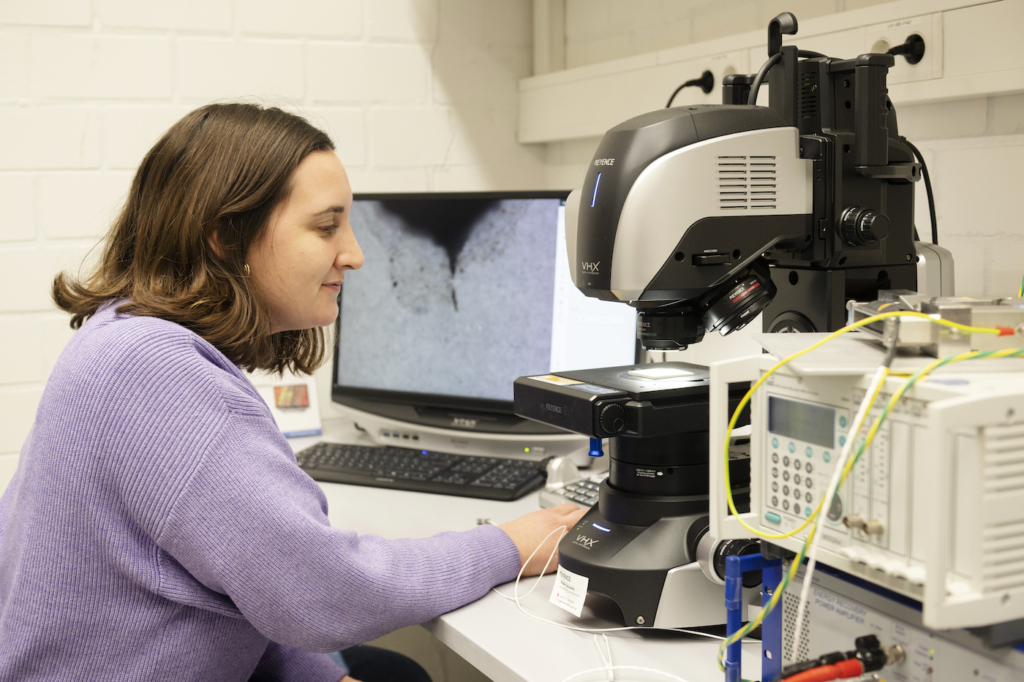Up not Down
Materials scientists at the UDE want to build new houses from old. Help is coming from an unexpected source – concrete rubble from a dilapidated bridge is being used to develop a high-quality recycling process for cement. The aim is to make building more climate-friendly in future.
By Juliana Fischer
Cement, water, and aggregates: combined in the mixer they produce concrete – the material that makes many of the bridges and buildings of our time possible. ‘Concrete can be moulded to any complex shape and it has high durability, that makes it practically unbeatable as a building material,’ says Dr Tommy Mielke, a civil engineer from the Institute for Materials Science at the UDE. However, the CO2 footprint of the composite is huge. ‘The production of cement alone, the binder of concrete, is responsible for up to eight percent of worldwide emissions of carbon dioxide,’ he explains.
So on the Up-Cement project, led by Prof. Dr Doru Lupascu, UDE researchers are focusing on reuse of the energy-intensive binder. ‘We want to create real high-quality recycling,’ explains PhD student Anne Zora Gierth. ‘On paper the statistics for recycling concrete look good, but very little CO2 is saved in the process.’ This is because it is mostly what is known as downcycling. That is, the building material is reused as an inferior product, for instance as a base material for road building. High-quality recycling on the other hand requires laborious separation – yet it could save resources and protect the climate.

FIRST SORT – THEN RECYCLE
When the dilapidated bridge Turmstraße in Aachen was de- molished in the summer of 2022, the materials scientists got to work on it. They transported 40 tons, crushed into countless pieces, to the laboratory in Essen and to their project partner at the TU Freiberg. The old concrete is particularly suited to scientific analysis because it was part of an extensively do- cumented public edifice, and because a bridge consists almost completely of concrete. ‘We know precisely what is in the concrete, and therefore can establish how much recyclate can be obtained using our methods and how high-quality it is,’ explains Mielke.
In order to obtain new raw material from the bridge rubble, the hardened cement must first be extracted from the solidified concrete. ‘Finding the right separation method for this is the first challenge in the recycling process,’ says Mielke. There is a range of possible processes which have to be compared: For instance, at the TU Freiberg they are testing the separation of the hardened cement from the residue using electrodynamic fragmentation.
The scientists also incorporate the types of crushers used at various recycling plants, including impact crushers and the SmartCrusher, in their analysis.

After crushing, the material is fractionated in the sieve tower at UDE and milled in a ball mill. But what is the ideal grain size for reprocessing? This is an important question, because: ‘In normal cement the rate of hydration and as a result its strength are determined by the grinding fineness,’ says Gierth. With the aid of the sieve tower and the mill, the researchers are undertaking numerous experiments into how this effect can also be used when working with recycled cement.
FINDING THE RIGHT TEMPERATURE
Cement is produced industrially from limestone. Excipients are added as the sedimentary rock is fired at temperatures of up to 1,450 degrees centigrade until it becomes cement clinker and is then finely milled. More than two-thirds of CO2 emissions from cement production are down to this firing process. The Up-Cement experts want to approach this in a more energy- efficient way, by reactivating the reused cementstone at a low temperature. ‘We are determining the optimal temperature – somewhere between 600 and 800 degrees – and the firing time with our trials on the concrete rubble,’ explains Mielke. ‘We also want to understand better what processes are taking place in the material when it is reactivated.’
Can the cement they obtain this way compete with the normal material? ‘That’s a real challenge,’ says Gierth. This is because the chemical composition of the recycled cement differs from the normal material. ‘As the components that create strength are present in a different proportion, we also see changes in the material properties,’ Gierth explains. She is already working in the laboratory on initial specimens of recycled material. Under the microscope and during tensile and strength tests, cracks and large pores become evident. So it is still necessary to tweak some of the settings in the crusher, mill, and furnace, to im- prove the material properties of the recycled cement.
At the same time, Mielke and Gierth constantly keep an eye to ensure the process is suitable for the building site. Until now, concrete rubble has to be shipped by truck to the recycling sites – a wasteful process. Fresh cement by contrast has a lengthy route to the construction site. The researchers want to change this by developing mobile containers that would separate the cementstone from old concrete on site, reactivate it at temperatures between 600 and 800 degrees centigrade, and then mill it into cement. ‘This would not only save on greenhouse gases with the lower temperatures for clinker production but also with the shorter transportation routes and fewer trucks on the roads,’ says Mielke. The civil engineer expects prototypes to be developed in the next ten years.

UPCYCLING INSTEAD OF DOWNCYCLING
The Institute for Materials Science and the Institute for Construction Operations and Management are developing methods to recycle waste high-quality cement in the Up-Cement project. The Institute of Mineral Processing Machines and Recycling Technology at the TU Bergakademie Freiberg is a cooperation partner. The project is being funded by the Ministry of Economic Affairs, Industry, Climate Action and Energy of the State of North Rhine-Westphalia until April 2025. UDE is receiving around 1.5 million euros of a total 1.7 million euros funding.

Main image: © Bettina Engel-Albustin



